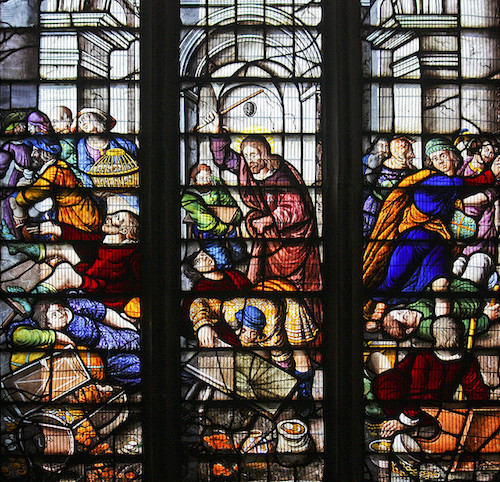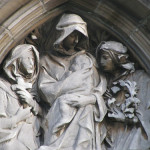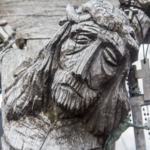We run our website the way we wished the whole internet worked: we provide high quality original content with no ads. We are funded solely by your direct support. Please consider supporting this project.

The Cleansing of the Temple and Non-Violence
Jesus’ cleansing of the Temple is the most commonly cited example of those who allege that he did not absolutize loving enemies or refraining from violence. I submit that this episode implies nothing of the sort. First, it is important that we understand that this episode was not an expression of unpremeditated anger on Jesus’ part, as some allege. Most NT scholars concur that this was a calculated, strategic act on Jesus’ part, and it contained deep symbolic significance. More specifically, this episode appears to be a classic example of a prophetic symbolic action.
There is, however, some disagreement over what exactly Jesus was symbolizing. For example, many argue that Jesus was revealing himself to be the long-awaited messiah who was widely expected to cleanse and/or restore the Temple. Others argue that Jesus was symbolically revealing Yahweh’s displeasure with the corrupt religious establishment and issuing a prophetic warning that the Temple would soon be destroyed, a point that John makes explicit (Jn 2: 19-22). While interpretations differ, however, they all presuppose that the Temple cleansing was anything but a spontaneous tantrum on the part of Jesus.
Second, there is simply no indication in any of the Gospels that Jesus resorted to violence when he cleansed the Temple. Yes, the texts suggest that Jesus was angry, and yes, John tells us that Jesus made a whip (Jn 2:15). But there is no suggestion that he used it to strike any animal or person. To the contrary, throughout history cracking a whip has been a commonly used means of controlling the movement of animals, and John explicitly reports that this is what Jesus used it for. He used the whip to create an animal stampede of “both sheep and cattle” out of the “temple courts” (Jn 2:15). Not only this, but had Jesus actually whipped any of the court officials, it is hard to imagine how he could have avoided being arrested on the spot. It is also hard to imagine how he could have avoided the charge of hypocrisy, for such behavior would have flown in the face of his previously mentioned public teachings about refraining from violence.
There is therefore nothing about Jesus’ cleansing of the temple that runs counter to my claim that the non-violent, enemy-embracing, self-sacrificial love that was supremely revealed on the cross is the thematic center of Jesus’ identity and mission. To the contrary, Jesus engaged in a kind of “street theater” out of love for his “Father’s house” as well as for the poor who were being oppressed by the corrupt leaders who ran the Temple’s “buying and selling” system. And, as the Gospels make clear, he confronted these leaders in this aggressive manner as a way of forcing their hand, and thus as a steppingstone to his crucifixion. Far from illustrating Jesus acting in an unloving, let alone violent way, I submit that this entire episode reflects Jesus’ self-sacrificial love.
Moreover, John explicitly makes the cross the thematic center of this episode, for he records that Jesus brings this episode to a close by drawing a connection between the newly cleansed temple, which Jesus prophesied would soon be permanently destroyed, and his own body, which would rise again three days after being destroyed (Jn 2:19-22). Read in context, NT scholar Richard Hays notes, John is declaring “that Jesus’ body is now the place where God dwells, the place where atonement for sin occurs, the place where the division between God and humanity is overcome.” Hence, far from counting against the thematic centrality of the cross, the Temple cleansing illustrates this centrality.
Photo credit: Lawrence OP via VisualHunt.com / CC BY-NC-ND
Category: General
Tags: Cross, Love, Non-Violence
Topics: Enemy-Loving Non-Violence
Related Reading

Is Having the “Right” Theology the Core of Christianity?
Last week, we posted a piece by Greg that challenges the practice being violent “in the name of Jesus” toward others who err theologically. (Click here to read this post.) Being that this piece got a lot of attention, we thought it worthwhile to provide some further explication to this point, especially in the light…

On Mental Illness and Jumping from a Burning Building
seyed mostafa zamani via Compfight Ann Voskamp wrote this piece in the wake of the suicide of Rick Warren’s son. It’s disheartening to hear so many thoughtless and cruel comments by other Christians when tragedies like this strike. But here is a voice of knowing and compassion. Here is love. From Ann’s blog post: I…

The Cross in the Manger, Part 2
While some shepherds were tending their flock, an angel appeared to them announcing “good news that will cause great joy for all the people,” for it news about “a Savior…the Messiah, the Lord” (Lk 2:10-11). Most Jews of this time expected a Messiah who would save them by vanquishing their Roman oppressors and liberating Israel…

Podcast: A Cross Vision Reading of David & Goliath
Dan takes a shot at interpreting the David & Goliath story through a cruciform lens. http://traffic.libsyn.com/askgregboyd/Episode_0294.mp3

Do the Gospels Fabricate Prophetic Fulfillment?
Skeptically-inclined scholars, and especially critics of Christianity, frequently argue that the Gospel authors created mythological portraits of Jesus largely on the basis of OT material they claim Jesus “fulfilled.” In other words, they surveyed the OT and fabricated stories about how Jesus fulfilled those prophecies. In response, it’s hard to deny that there are certain…

The Cruciform Trinity
As paradoxical as it sounds, if God is supremely revealed when he stoops to the infinite extremity of becoming his own antithesis on the cross, then we must conclude that stooping to this extremity out of love must, in some sense, be intrinsic to who God eternally is. And rendering this coherent necessitates that we…
